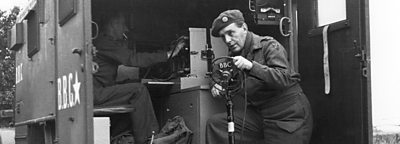The War proved to be a tough test of the 大象传媒's independence. At times the Government and the military wanted to use the 大象传媒 to counter crude propaganda from the Nazis, and there was talk in Westminster of taking over the 大象传媒.
The temptation to interfere was greatest in the early days of the war, when the Government was confronted with the startling success of William Joyce, known as 'Lord Haw-Haw' to the millions of British listeners who tuned to Radio Hamburg. Through the first months of the war - the 'phoney war', in which no direct threat to the UK was evident - Haw Haw's humorous take on Britain and the British proved light relief from the dull diet of the Home Service.
But the Corporation argued that to put out clumsy rebuttals at the behest of Government would dignify Haw-Haw's propaganda, and undermine the trust of the audience. In the long run, a trusted news source for audiences at home and abroad would be a more potent weapon.
In fact the Government had recognised this long before hostilities broke out. Throughout the 1930s, as the Nazi threat was looming over Europe, then Director-General John Reith was in secret discussion with the Cabinet over broadcasting arrangements in the event of war. It was agreed that the 大象传媒 should seek to report events truthfully and accurately, but not in such detail as to endanger the civilian population or jeopardise operations.
The result was that the 大象传媒 did report setbacks as well as successes. It would say, for instance, that bombs had fallen and that there were casualties. But precise number of casualties and the location and time of a bombing would often be withheld, so that the enemy would not know which of its missions had found the target.
But in practice, the 大象传媒 and the Goverment did not always see eye to eye in squaring what the nation needed to know with what the Ministry of Information felt should be concealed, and at times the relationship was difficult. Frederick Ogilvie, who had succeeded John Reith as Director-General in 1939, found the pressure too great, and he resigned early in 1942.
Listening to 大象传媒 broadcasts (or any other banned broadcasts) in occupied countries was often punishable by death. In Poland it was illegal to even possess a radio. For these audiences the 大象传媒 broadcast a special news service in morse code, so that sympathisers could publish the reports in their illegal newspapers.
The correspondents were equally frustrated. Frank Gillard's report of the futile assault at Dieppe in 1942, when more than 3,000 Canadian troops were killed, wounded or captured, was heavily censored, to his life-long disgust. And after the German surrender in 1945, Richard Dimbleby threatened to quit if the 大象传媒 did not put out his report on the horrors of Belsen. As it was, the Corporation delayed the broadcast for a day while it considered the impact that such stark revelations about the Holocaust would have at home and abroad..
In many ways the World War 2 made the 大象传媒. The fact that for decades after the war people in the Iron Curtain countries risked their lives to listen to the 大象传媒 is testimony to the reputation for integrity that it built up in the face of the Nazi threat.
Lord Haw-Haw
William Joyce was a UK citizen who, at the height of his popularity as a Hamburg Radio announcer, drew audiences of six million with his entertaining commentary on British life each evening after the 9 o'clock news. But there was a sinister side to his broadcasts, which sought to undermine the allied war effort, and which were worryingly well-informed.
In one broadcast he gave a special mention 'to all of the 大象传媒 based out in Evesham', to the infuriation of the staff. Two curious facts about Joyce: his brother worked at the 大象传媒 until he was persuaded by events to join the army; and the Germans bombed the family home in London during the blitz. After the Nazi surrender Joyce was tried and hanged for treason.
The Battle of the Beams
During World War 2 大象传媒 engineers were engaged in a secret and highly technical battle with the Luftwaffe.
The Nazis introduced their 'Knickebein' (crooked leg) navigation system, which used two radio signals, transmitted from two different sites in occupied Europe, to guide bombers to their targets in Britain. The two beams would be aimed so that they crossed above the target. Pilots would fly along one beam, and release their bombs when they picked up the signal from the other.
But after the British thwarted these assaults by putting out spoiler signals from UK transmitters on the same frequencies, the Germans devised the X-Gerat system. This was similar, but used several cross-signals to give greater accuracy. The destruction of Coventry on 14 November 1940 is testimony to just how devastating it could be.
Then, when the British worked out how to jam that system, the Nazis introduced even more sophisticated technology, the Y-Gerat system. A single transmitter, using two signals of different frequencies, would point the bombers in the right direction, and then tell them when they were over the target.
But by now, thanks to information gleaned from German PoWs, the British were ahead of the game, and 大象传媒 engineers based at Alexandra Palace deployed their London transmitters - idle since the closure of the television service on the day war was declared - to beam Y-Gerat signals back at the advancing aircraft, and thus confuse their instruments.
The Unmentionables
For most of the war the broadcasters were banned from mentioning the weather. No references to conditions more recent than the day before could be given out, as this would reveal conditions for bombing. Other unmentionables were names of military regiments, or the whereabouts of members of the Royal Family.
